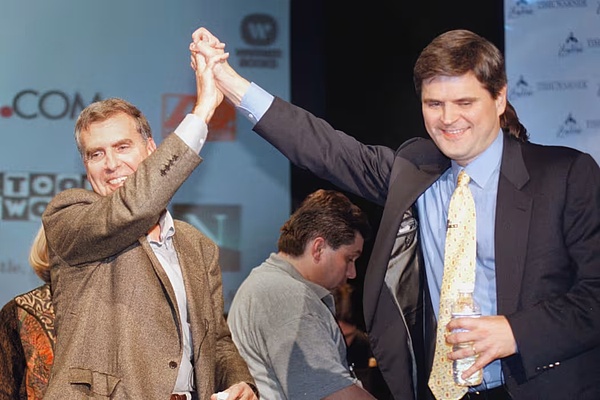The macroeconomic backdrop 25 years ago was very different from today, but the endings of each cycle are strikingly similar.
While 25th anniversaries are usually cause for celebration, the 25th anniversary of the dot-com bubble burst is bittersweet for investors. 25 years ago, the dizzying dot-com bull market peaked, and the U.S. stock market entered a bear market, dragging the U.S. economy into recession after a decade of expansion.
The Dow Jones Industrial Average peaked in January 2000, and the S&P 500 and Nasdaq Composite peaked two months later. During this period, Barron's published a historic cover story on March 20, 2000, titled "Burning Up," which pointed out that dot-com companies were burning through the money that overzealous investors (or more accurately, speculators) had thrown at them at a frightening rate.
After the article was published, it immediately attracted a series of sharp criticisms, but it turned out that Barron's judgment was correct. As this prescient article pointed out, a lot of money was invested in startup projects doing business on the Internet, and they went up in smoke along with these funds.

A sense of déjà vu came over me. James Grant, a renowned financial historian, recently wrote in Grant’s Interest Rate Observer, “Readers of a certain age will soon recall the bust in fiber-optic communications at the turn of the millennium. Today, as in 1998-2002, technology companies are highly vulnerable to overexcitement, overordering, and overbuilding.”
The tech “Big Seven” that generate a lot of free cash flow are investing heavily in artificial intelligence. Barron’s recently reported that Meta Platforms, Microsoft, and Alphabet are estimated to invest $200 billion in artificial intelligence this year, about a quarter of the three companies’ combined revenue. With DeepSeek, launched in China, able to produce artificial intelligence models at a lower cost, “American exceptionalism” is being questioned, or at least how much return the US tech giants can get from their huge investments in artificial intelligence.
Grant also pointed to the US government’s practice of throwing all its resources at artificial intelligence, especially data centers, as another warning sign. Before leaving office, the Biden administration directed the Department of Defense and the Department of Energy to lease land owned and managed by the federal government to speed up approvals for new data center construction. The newly-appointed Trump administration, along with SoftBank Group, OpenAI and Oracle, quickly launched the Stargate project, which is expected to cost the companies between $100 billion and $500 billion. This follows the U.S. government's announcement of new data center construction projects in early 2023 that will require the combined power of all 94 nuclear reactors in the United States. Grant believes that this boom-and-bust will not only put data center companies out of business, but will also spread to the entire technology industry and credit markets.
January also marked the 25th anniversary of the $350 billion merger of America Online and Time Warner. The deal is often seen as the apex of the Internet bubble and the worst destruction of shareholder value in business history.

In January 2000, Time Warner CEO Gerald Levin (left) and AOL CEO Steve Case announced the merger of their two companies, marking the peak of the Internet boom.
Grant's colleague Evan Lorenz believes that Musk's unsolicited offer to acquire OpenAI for $97.4 billion is similar to AOL's deal with Time Warner. He wrote in the latest issue of Grant's Interest Rate Watch that Musk may need to triple his bid because SoftBank's proposed $40 billion investment would value OpenAI at $300 billion. “In the hottest sectors of the economy, the biggest M&A deals never come at the bottom of the cycle,” Lorenz wrote.
The dot-com bubble and bust aren’t the only precedents for today’s tech sector. Radio Corp. of America was the first standout tech stock of the “Roaring 20s,” and “all you had to do was put the word ‘radio’ in the name and the stock price would soar, even if there was little substance behind it,” Bryan Taylor, chief economist at data provider Finaeon, wrote in a 2023 article. RCA’s stock rose 200-fold in the 1920s, but by 1932 it had fallen 98% from its 1929 peak.
General Electric bought RCA in 1986 for 72% above its 1929 peak, but U.S. consumer prices rose more than 500% over the same period, so RCA stock was a loser in real terms in the decades that followed, even as radio and television grew far beyond what the bulls of the "Roaring 20s" had expected.
Admittedly, the macroeconomic backdrop 25 years ago was very different from today. At the time, Treasuries were in demand and the federal budget was in surplus, Grant said. That is no longer the case, as spending from two Middle East wars, the 2007-2009 financial crisis and the coronavirus pandemic, along with the expansion of programs like Obamacare, have left the U.S. deficit at levels not seen outside of wartime.
According to the Congressional Budget Office, the annual U.S. fiscal deficit will average about $2 trillion over the next 10 years, equivalent to 6.2% of GDP this year.
This means that in the coming years, artificial intelligence will compete with "Uncle Sam" for funds. According to the CBO's estimates, the main driver of the deficit will be interest payments, which will account for 3.2% of GDP, higher than the 3% of the basic deficit (the deficit after interest payments) and will not be affected by any measures of the "Department of Government Efficiency" (DOGE).
Grant said in an interview that although the environment we are in has changed, the ending of each cycle is surprisingly similar. This time, I am afraid it will be difficult to say "Happy Anniversary."
 Jasper
Jasper









